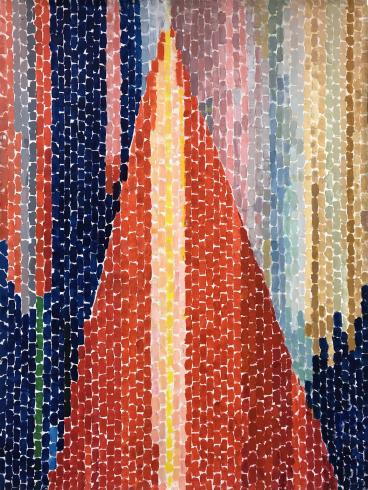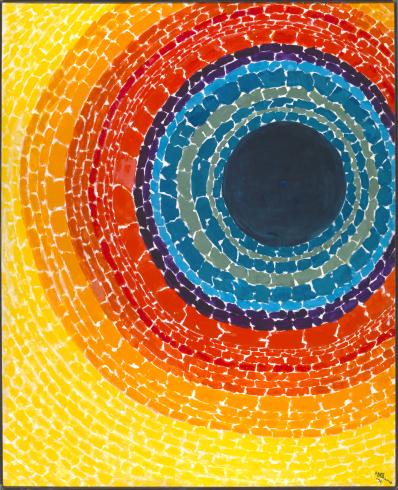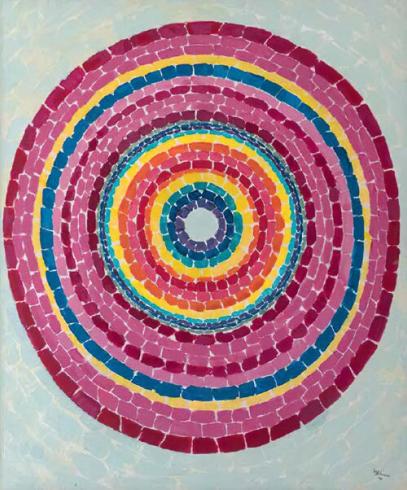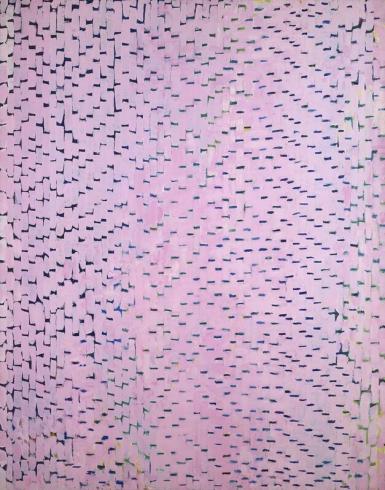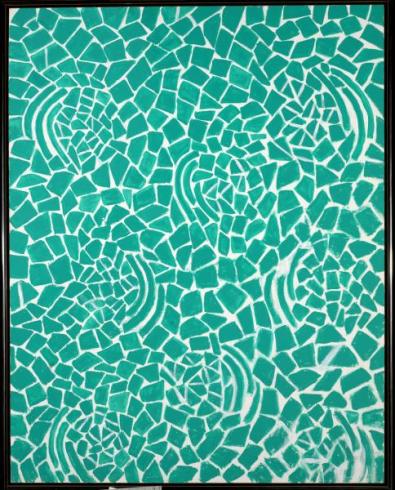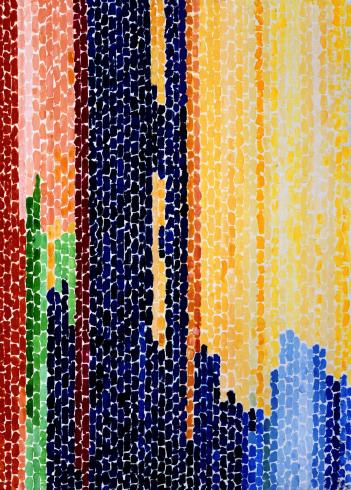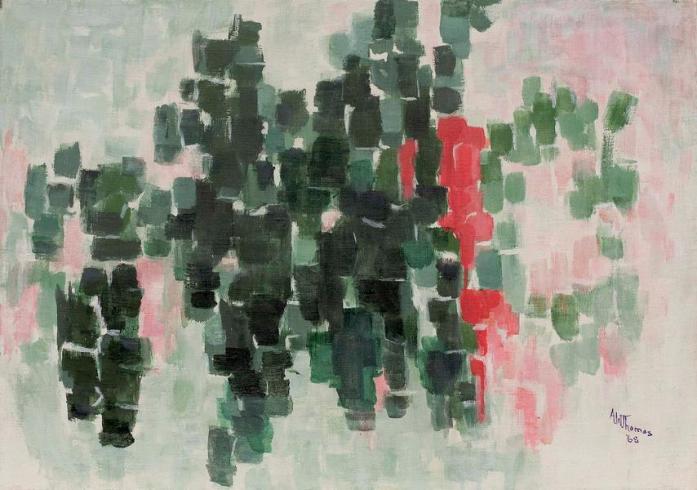The Abstract Art of Alma Thomas
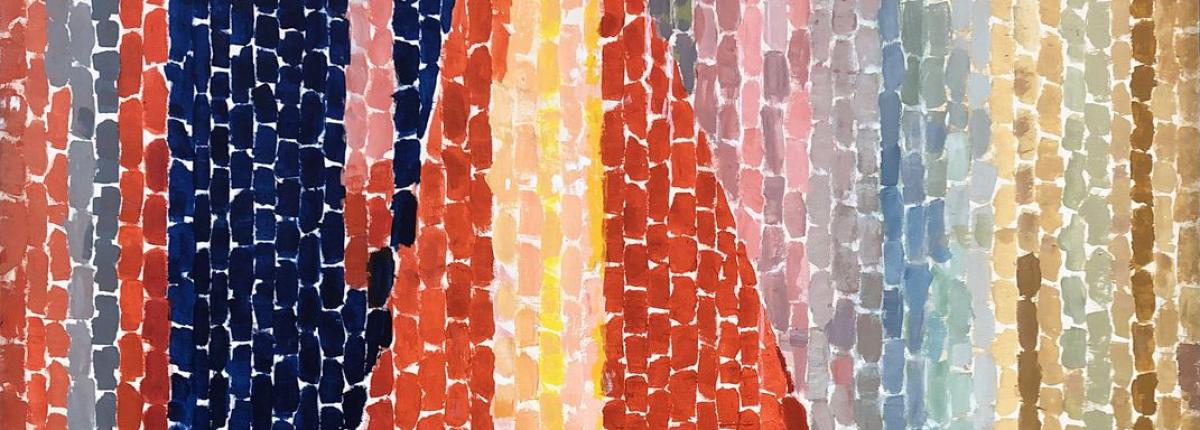
Part 1: What makes art abstract?
- Show students the first image on the Comparing a Painting to a Photograph guide.
- Show students each page of this document at different times, being careful not to initially share the title of the painting.
- Have students study the painting for two minutes. After the two minutes are up, as a whole class, discuss responses the following questions:
- How did you feel while looking at the painting? Did your feelings change as you looked at the painting longer? Explain.
- What colors did you notice?
- What thing from real life does this painting remind you of?
- Next, show students the second image on the Comparing a Painting to a Photograph guide. As a whole class, discuss responses to the following questions:
- How do you feel looking at this picture?
- What colors do you notice?
- What is happening in this picture?
- Explain to students that Alma Thomas was inspired by the natural world, space, and current events. In the late 1960s and early 1970s, the United States was deeply engaged in space exploration. When the first astronauts traveled to the moon, Thomas wanted to capture that event. She does so in this painting of Apollo 11, which was the first spacecraft to bring humans to the moon, in 1969.
- Science Connection: Share with students that there were three astronauts: Neil Armstrong, Buzz Aldrin, and Michael Collins who were chosen by NASA to make the trip from Earth on Apollo 11. They left Earth on July 16, 1969.
- After launching into space, Collins remained on the command module and continued to orbit around the moon while Armstrong and Aldrin boarded the Eagle (a smaller module of the spacecraft) and went down to the moon’s surface.
- Once the Eagle landed, Armstrong exited first and became the first person on the moon.
- Armstrong and Aldrin planted the U.S. flag on the surface and spent some time collecting samples of moon rocks and dust to bring back to Earth. They returned to Earth eight days later, on July 24, 1969.
- Science Connection: Share with students that there were three astronauts: Neil Armstrong, Buzz Aldrin, and Michael Collins who were chosen by NASA to make the trip from Earth on Apollo 11. They left Earth on July 16, 1969.
- Show the images of Apollo 11 side-by-side (on the last page of the document). In this particular painting, Thomas captured the event of Apollo 11 blasting off. Ask students the following questions:
- Thomas’s painting is called Blast Off. Looking at these images side-by-side, how does this change what you thought the painting was showing initially? Explain your thoughts.
- How do your feelings of looking at the two images compare?
- What colors from the Apollo 11 photograph does Thomas’s painting include?
- In what other ways, in addition to the colors, does the painting remind you of the Apollo 11 photograph?
- Explain to students about Thomas’s shift from representational to abstract art:
- Alma Thomas created art later in her life that moved away from representing exactly what she saw and, instead, focused on expressing how she felt when she looked at something. She wanted to express a particular mood about nature or an event, rather than the object or event itself.
- Representational art is used to show the world. In other words, you can tell exactly what objects or events the artist was trying to show—almost like a photograph!
- Students will explore what makes art abstract by looking at more paintings by Alma Thomas.
- In groups of 3-4, have students complete What makes art abstract? worksheet.
- As a whole class discuss:
- Based on what you studied in Alma Thomas’s paintings, how would you define abstract art? What did you notice about the shapes, colors, and lines?
Part 2: The Art of Alma Thomas
Explore:
- Alma Thomas often painted what she saw in the world, but she eventually realized that representing exactly what she saw did not make her happy. She once said, “I was doing representational painting. But I wasn’t happy with that, ever. I watched other people painting abstractly, and I just kept thinking about it, turning it over and over in my mind.”
- Ask students:
- Why do you think an artist would be drawn to creating abstract art?
- What makes abstract art interesting, in your opinion?
- What makes representational art interesting, in your opinion?
- Which type of art is most interesting to you? Why?
- Ask students:
- Now, explain to students that they will explore how creating a place or event abstractly, as opposed to representationally, can change the experience the audience has of that place or event.
- In pairs, have students work on The Art of Alma Thomas: Exploration Guide.
- As a whole class, discuss responses to the questions on the exploration guide. Ask students:
- How did Alma Thomas capture in her artwork the places and events by which she was inspired?
Part 3: Creating Your Own Abstract Art Like Alma Thomas
- Thomas often found inspiration just outside her home. She said:
“I sat down right in … that red chair in my living room, and I looked at the window. And you can see exactly what I saw, right before my eyes, from where I was sitting in the chair. Why, the tree! The holly tree! I looked at the tree in the window, and that became my inspiration….And every morning since then, the wind has given me new colors through the windowpanes.”
- Students will create their own abstract art like Thomas, using crayons, markers, and/or paint. Have students use this planning guide to get them started.
- After completing the planning guide, create the abstract artwork!
Share:
- Have students share their pieces with the class.
- Students who are viewing the artwork should:
- Share what they think inspired their classmate’s piece
- Describe the mood of the piece
Additional Context
Lesson Context
Alma Thomas was a Black artist from Washington, DC. At the beginning of her career, her art was representational in nature, capturing what she saw and experienced. As she got older, she realized that she wasn’t happy with that artistic approach. She said:
“I was doing representational painting. But I wasn’t happy with that, ever. I watched other people painting abstractly, and I just kept thinking about it, turning it over and over in my mind.”
Therefore, in her 70s, Thomas began painting in a completely new way. Her new artistic style—which features bold, vibrant colors, mosaic-like patterns, creates a sense of movement, and emphasizes what she found to be beautiful—is what she is best known for today
Key Terms
Abstract Art: A style of art that does not attempt to represent the real world as is, but instead aims to capture its effects through shapes, lines, and color.
Mood: A feeling created by the artist through their artwork. Mood is often a more general feeling after looking at or studying something for a long time. Emotions are typically temporary. For example, when you first look at a painting, you may feel several emotions—excitement, joy, or happiness. The longer you study the painting those emotions will fade and a general mood will emerge, such as hope or light-heartedness.
Representational Art: Artwork that clearly depicts real objects. The artist represents something that is real and the audience is able to easily recognize the objects or figures in the artwork.
